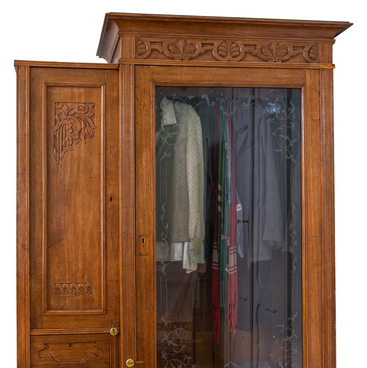It is believed that the first etagères appeared in the Renaissance; then only wealthy Europeans could afford this piece of furniture. The word ‘étagère’ was first recorded in the 18th century. It derives from the French ‘etage’, which translates as ‘floor of a building’. The great fashion for bookcases began during the reign of Louis XVI, who reigned up to the French Revolution.
At that time, all furniture was made of precious wood: oak, walnut and cherry. Often the etagères had openwork, quite weightless designs. This object was used to display collections of curiosities, rare books and other accessories that were brought from different countries. Thus, etagères became an inseparable part of an aristocratic salon of the time.
At the end of the 18th century, mass production of étagères began in France. Most often cabinetmakers made to order small low structures. Later they began to use metals on a mass scale, in particular copper and brass. Sometimes gold with inserts of precious stones was also used. These bookcases were considered works of art and were very expensive. In 1842 Nikolai Gogol wrote in his poem ‘Dead Souls’: ‘No frescoes, no paintings on the walls, no bronze on the tables, no etagères with porcelain or cups, no vases, no flowers, no statues — in a word, sort of hungry’. In Russia, the étagère was perceived in the same way, more as an element of decoration than as a full-fledged piece of furniture.
The second peak of popularity of étagères was in the Victorian epoch — the end of the 18th — the beginning of the 19th century. At that time, the shelves had gilded carved figures and mirrors. Soon the decorative extravagance went out of fashion and this piece of furniture became more functional. From the beginning of the 20th century étagères began to be used in different industries, including navigation — they were installed for the needs of the crew on ships. Metal constructions appeared followed by designer products. The first shelving units were also created based on étagères — another piece of furniture that is still found in almost every home today.
At that time, all furniture was made of precious wood: oak, walnut and cherry. Often the etagères had openwork, quite weightless designs. This object was used to display collections of curiosities, rare books and other accessories that were brought from different countries. Thus, etagères became an inseparable part of an aristocratic salon of the time.
At the end of the 18th century, mass production of étagères began in France. Most often cabinetmakers made to order small low structures. Later they began to use metals on a mass scale, in particular copper and brass. Sometimes gold with inserts of precious stones was also used. These bookcases were considered works of art and were very expensive. In 1842 Nikolai Gogol wrote in his poem ‘Dead Souls’: ‘No frescoes, no paintings on the walls, no bronze on the tables, no etagères with porcelain or cups, no vases, no flowers, no statues — in a word, sort of hungry’. In Russia, the étagère was perceived in the same way, more as an element of decoration than as a full-fledged piece of furniture.
The second peak of popularity of étagères was in the Victorian epoch — the end of the 18th — the beginning of the 19th century. At that time, the shelves had gilded carved figures and mirrors. Soon the decorative extravagance went out of fashion and this piece of furniture became more functional. From the beginning of the 20th century étagères began to be used in different industries, including navigation — they were installed for the needs of the crew on ships. Metal constructions appeared followed by designer products. The first shelving units were also created based on étagères — another piece of furniture that is still found in almost every home today.



